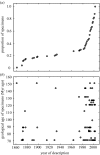The quality of the fossil record of Mesozoic birds
- PMID: 15705554
- PMCID: PMC1634967
- DOI: 10.1098/rspb.2004.2923
The quality of the fossil record of Mesozoic birds
Abstract
The Mesozoic fossil record has proved critical for understanding the early evolution and subsequent radiation of birds. Little is known, however, about its relative completeness: just how 'good' is the fossil record of birds from the Mesozoic? This question has come to prominence recently in the debate over differences in estimated dates of origin of major clades of birds from molecular and palaeontological data. Using a dataset comprising all known fossil taxa, we present analyses that go some way towards answering this question. Whereas avian diversity remains poorly represented in the Mesozoic, many relatively complete bird specimens have been discovered. New taxa have been added to the phylogenetic tree of basal birds, but its overall shape remains constant, suggesting that the broad outlines of early avian evolution are consistently represented: no stage in the Mesozoic is characterized by an overabundance of scrappy fossils compared with more complete specimens. Examples of Neornithes (modern orders) are known from later stages in the Cretaceous, but their fossils are rarer and scrappier than those of basal bird groups, which we suggest is a biological, rather than a geological, signal.
Figures





Similar articles
-
The completeness of the fossil record of mesozoic birds: implications for early avian evolution.PLoS One. 2012;7(6):e39056. doi: 10.1371/journal.pone.0039056. Epub 2012 Jun 25. PLoS One. 2012. PMID: 22761723 Free PMC article.
-
The Paleogene fossil record of birds in Europe.Biol Rev Camb Philos Soc. 2005 Nov;80(4):515-42. doi: 10.1017/S1464793105006779. Biol Rev Camb Philos Soc. 2005. PMID: 16221327 Review.
-
Bird evolution in the Eocene: climate change in Europe and a Danish fossil fauna.Biol Rev Camb Philos Soc. 2006 Nov;81(4):483-99. doi: 10.1017/S146479310600707X. Epub 2006 Aug 8. Biol Rev Camb Philos Soc. 2006. PMID: 16893476 Review.
-
Avian evolution, Gondwana biogeography and the Cretaceous-Tertiary mass extinction event.Proc Biol Sci. 2001 Mar 7;268(1466):459-69. doi: 10.1098/rspb.2000.1368. Proc Biol Sci. 2001. PMID: 11296857 Free PMC article. Review.
-
The shape of pterosaur evolution: evidence from the fossil record.J Evol Biol. 2009 Apr;22(4):890-8. doi: 10.1111/j.1420-9101.2008.01682.x. Epub 2009 Jan 29. J Evol Biol. 2009. PMID: 19210587
Cited by
-
Little evidence for enhanced phenotypic evolution in early teleosts relative to their living fossil sister group.Proc Natl Acad Sci U S A. 2016 Oct 11;113(41):11531-11536. doi: 10.1073/pnas.1607237113. Epub 2016 Sep 26. Proc Natl Acad Sci U S A. 2016. PMID: 27671652 Free PMC article.
-
Extinction rates of non-avian dinosaur species are uncorrelated with the rate of evolution of phylogenetically informative characters.Biol Lett. 2020 Jun;16(6):20200231. doi: 10.1098/rsbl.2020.0231. Epub 2020 Jun 24. Biol Lett. 2020. PMID: 32574533 Free PMC article.
-
Darwin's dilemma: the realities of the Cambrian 'explosion'.Philos Trans R Soc Lond B Biol Sci. 2006 Jun 29;361(1470):1069-83. doi: 10.1098/rstb.2006.1846. Philos Trans R Soc Lond B Biol Sci. 2006. PMID: 16754615 Free PMC article. Review.
-
The completeness of the fossil record of mesozoic birds: implications for early avian evolution.PLoS One. 2012;7(6):e39056. doi: 10.1371/journal.pone.0039056. Epub 2012 Jun 25. PLoS One. 2012. PMID: 22761723 Free PMC article.
-
Dinosaurs and the Cretaceous Terrestrial Revolution.Proc Biol Sci. 2008 Nov 7;275(1650):2483-90. doi: 10.1098/rspb.2008.0715. Proc Biol Sci. 2008. PMID: 18647715 Free PMC article.
References
-
- Benton M.J. Mass extinctions among families of non-marine tetrapods: the data. Mém. Soc. Géol. France. 1987;150:21–32.
-
- Benton M.J. Testing the time axis of phylogenies. Phil. Trans. R. Soc. B. 1995;349:5–10.
-
- Benton M.J. The quality of the fossil record of vertebrates. In: Donovan S.K., Paul C.R.C., editors. The adequacy of the fossil record. Wiley; New York: 1998. pp. 269–303.
-
- Benton M.J. Early origins of modern birds and mammals: molecules vs. morphology. Bio Essays. 1999;21:1043–1051. - PubMed
-
- Benton M.J. Finding the tree of life: matching phylogenetic trees to the fossil record through the 20th century. Proc. R. Soc. B. 2001;268:2123–2130. doi:10.1098/rspb.2001.1769 - DOI - PMC - PubMed
Publication types
MeSH terms
LinkOut - more resources
Full Text Sources

